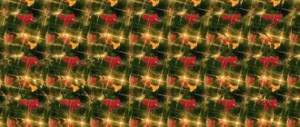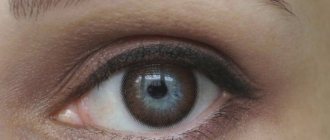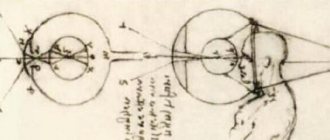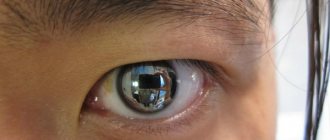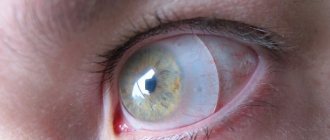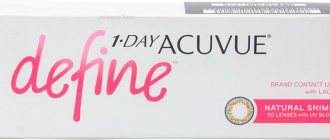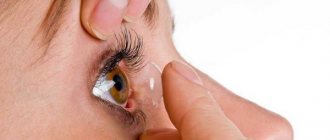What are scleral lenses?
Optics first appeared in the USA in the 90s. Initially, they were used for therapeutic purposes to eliminate pathologies affecting the cornea. Unlike traditional products, scleral contact lenses have several characteristic features:
- To eliminate the risk of irritation, it is necessary to constantly use a drug from the “artificial tear” category;
- The optics have a large diameter (instead of the classic nine millimeters, it is equal to 2.2 centimeters);
- The lenses have a convex shape.
Polymacon is used to make eyepieces; this material has a high degree of permeability and allows oxygen to pass through well. This minimizes the risk of swelling of the cornea and does not cause discomfort while wearing.
Optics are divided into three types:
- Corneoscleral. Only the cornea is covered, while the protein of the organ of vision remains free. The size of the product is one and a half centimeters;
- Mini version. They cover the entire membrane and reach the protein area of the eye. Their diameter is eighteen millimeters;
- Covering the cornea completely. They create a frightening effect; contact with the shell occurs only at the upper and lower borders.
The selection of eyepieces depends on medical indications and the desire to achieve a particular effect.
Selection of scleral lenses at Optik-Center
Selection is a rather complex process. Since each lens is produced individually, selection requires a thorough eye examination and calculation of parameters.
The examination for the selection of scleral lenses consists of:
- a complete ophthalmological examination (includes determination of refraction, vision test, measurement of intraocular pressure, biomicroscopy, fundus examination and consultation with a doctor) - is carried out in advance and immediately precedes the selection;
- selection of a scleral lens (keratometry, keratotopography, fitting of design lenses, slit-lamp examination, training in handling and care skills).
The selection procedure consists of several stages. At the first visit, the ophthalmologist conducts an examination and calculates the parameters. Next, the design lens is tried on and the fit is assessed. Afterwards, the patient is released for 4 hours to independently assess comfort and quality of vision. After 4 hours, the landing is re-evaluated. The patient is subsequently monitored every 3-4 months.
Scleral lenses at Optik - Onefit scleral lenses from Okvision are selected, which are made from Contamac Optimum Extra material (UK) with a high oxygen permeability coefficient (100x10).
OKVision® Onefit™ scleral lenses are suitable for patients with high degrees of myopia and hyperopia, astigmatism, corneal transplant conditions, any degree and type of keratoconus and induced ametropia.
OKVision® Onefit™ scleral lens design options - spherical, Sym Toric, multifocal, and extra limbal clearance - provide unlimited visual acuity and comfort.
Wearing mode
It is recommended to wear scleral lenses no more than 12-14 hours a day, and they must be removed before going to bed.
Unlike soft contact lenses, a pair of scleral lenses will last you a very long time - from 1 to 1.5 years. But it is very important to properly care for them and follow the wearing regime.
For care you will need: peroxide solution for cleaning and disinfection, storage solution, saline solution for putting on, moisturizing drops and a suction cup for putting on scleral lenses.
Although scleral lenses are rigid and have a large diameter, which can look intimidating at first glance, they are much more comfortable than regular soft lenses! Many note that these are the most comfortable lenses patients have ever worn. This is explained by the fact that the lens practically does not move and rests on the most insensitive part of the eye.
Several arguments in favor of Optic-Center
- Individual approach.
Scleral lenses are selected and manufactured strictly individually based on the examination results.
- Professionalism.
The doctors of the Optic Center clinic were trained at the Academy of Medical Optics and Optometry, Moscow.
- Technologies
. The Optic Center clinic has all the necessary modern equipment for diagnostics and selection of scleral lenses.
- Training and recommendations.
After selection, our specialists will definitely teach you the correct use of lenses, as well as select the necessary related products for caring for scleral lenses.
- All inclusive
. The cost of scleral lenses includes: a complete ophthalmological examination, one pair of lenses, care and storage products (drops, two types of solution, a special container, a suction cup for removing lenses), training and a year of free observation.
| Fitting and scleral lenses (includes full examination, lenses, care and storage supplies, training and one year of free follow-up) | |
| Comprehensive examination before selecting scleral lenses | 4,400 rub. |
| Scleral lens 1 piece | RUB 18,150 |
Anyone can use the service at the Optic-Center ophthalmology clinic at 40 Let Oktyabrya, 15.
Areas of use
Scleral lenses are used not only for therapeutic purposes, but also to achieve a unique visual effect. Eyepieces are also used to track the movements of the eyeball. A similar procedure is necessary when conducting various tests. For analysis, special products are used that are equipped with magnetic field sensors.
In medicine, scleral optics are prescribed to combat the following pathologies:
- Damage to the visual apparatus;
- Severe form of dry eye syndrome;
- Neurotrophic keratitis;
- Burn of the eyeball due to high temperatures or chemicals;
- Keratoconus;
- Pathologies that appeared after surgery for corneal transplantation;
- Violation of the development of the eyeball.
Optics are prescribed to combat complications that appear after laser vision correction. Doctors recommend scleral lenses if the patient has an individual intolerance to classic eyepieces of smaller diameter.
Decorative models do not have a therapeutic effect, but are used to create a scary image in movies or at themed parties. However, they cannot be worn for a long time; the maximum period is three hours. The reason lies in the fact that eyepieces significantly narrow the optical view and can cause irritation of the mucous membrane.
| Decorative lenses can be purchased at an optical store or have a custom design made. Author's models will cost a little more than regular options. |
Return to contents
What vision problems are scleral lenses used for?
Scleral lenses have excellent optical characteristics; with the help of these lenses, vision correction is carried out for myopia, farsightedness (including age-related), and astigmatism.
Based on the advantages of the design, the use of scleral lenses may be indicated for the following diseases of the visual organs:
- dry eye syndrome;
- neutrophic keratitis;
- mechanical eye injuries;
- thermal and chemical burns of the eyes;
- complications after corneal transplantation;
- corneal dystrophy;
- keratoconus;
- aniridia;
- Steven-Johnson syndrome;
- microphthalmia, etc.
The benefits of using scleral lenses using the example of keratoconus ▼ The benefits of using scleral lenses can be illustrated by the example of keratoconus, a dangerous eye disease in which the cornea thins due to pathological structural changes, and then, under the influence of intraocular pressure, bulges, taking on a conical shape instead of the normal, spherical one. As a rule, the use of hard contact lenses is recommended to improve visual acuity in keratoconus. Speaking about the preferable choice of scleral lenses, it should be noted that lenses of small diameter, resting on the altered cornea, can move noticeably when blinking, which does not happen when using lenses of larger diameter, which are fixed in the eye more reliably. The scleral lens does not put pressure on the cornea, maximally covering the cone formed as a result of the disease.
Thanks to their design features, such lenses allow not only effective vision correction, but in some cases, slow down the progression of keratoconus!
Pros and cons of optics
The advantages of the products include:
- Flexible and very soft materials are used to produce eyepieces;
- Expensive models made from high-quality polymers can be worn without taking them off for three days without fear of damaging the cornea;
- The lenses have a high safety margin, their total service life is up to two years. Due to the unique characteristics of polymacon (the raw material used to create eyepieces), the optics require minimal maintenance;
- The surface of the lenses is not subject to scratches or cracks;
- The products allow oxygen to pass through well due to the presence of a large number of pores. As a result, the risk of developing hypoxia of the cornea is eliminated;
- Since scleral lenses do not fit tightly to the eyeball, the process of washing the eye with tear fluid is not disrupted.
Among the disadvantages of optics, consumers note the high cost of the product. One pair costs about four thousand rubles, but it can be worn for several years. Another disadvantage is the lengthy selection of eyepieces. Even with the help of an experienced ophthalmologist, the procedure sometimes takes up to fourteen days.
Black scleral lenses
Often in movies you can see characters with completely red, white or black eyes. It is not recommended to use such models all day long, since wearing them causes a tunnel effect. This leads to optical aberrations and visual fatigue.
After removing the lenses, place them in a container and fill them with a special solution. It is advisable to change the liquid every day, and also clean the container regularly. Do not use tap water to rinse the container. It is better to purchase distilled one, after adding a protein tablet to it. This is an alternative option if you don’t have a special cleaning solution at hand.
Black lenses are made from silicone hydrogel, since the products are decorative; manufacturers do not want to spend money on expensive materials. But some companies use hard materials to reduce the price tag of the product. Such models cause irritation, oxygen starvation and can provoke the development of dry eye syndrome.
How to remove scleral lenses from your eyes?
The algorithm for removing these contact correction devices is quite simple. It is necessary to release the lower part of the lens rim, moving the lower eyelid as far as possible. Next, you need to pinch the lower edge of the product with two fingers and pull it down parallel to the surface of the face with minimal impact on the upper eyelid.
After removal, the contact correction means must be disinfected using a special solution for gas-permeable optical products, and also placed in a container filled with fresh liquid. As a rule, any scleral lenses - black, white and others - are designed for long-term use, and therefore require additional enzymatic (enzymatic) cleaning.
To do this, you can use a special solution or tablet that dissolves in distilled water. It is recommended to perform the procedure once a week to remove deep protein and lipid deposits from the surface of the lens. After the expiration date, optical products must be disposed of and replaced with a new pair, even if they have retained their characteristics. Subject to proper care and replacement schedule, any scleral lenses, including black and white lenses, are safe for eye health.
How to choose the right one?
Scleral eyepieces are usually custom-made. To obtain accurate parameters, you need to visit an ophthalmologist, the doctor will take the necessary measurements and write a prescription. However, the adaptation period does not go smoothly for everyone.
During this period, you need to regularly visit the doctor, he will regulate the process of addiction. In some cases, additional adjustments are made to achieve an optimal fit.
After the adaptation period, markings are made on the front side of the optics, then the desired design or pattern is applied. Because initially the scleral lens is completely transparent. The service life of the product largely depends on the type of dye used, as well as on the raw materials. The highest quality models can be worn for up to five years.
How to choose scleral contact lenses with diopters?
By calling 8 (800) 500-50-58, you can sign up for an initial examination by an ophthalmologist and computer vision diagnostics. Modern equipment allows you to most accurately assess the quality of vision, as well as identify existing problems and structural features of the eye.
You can undergo diagnostics, get specialist advice and order individual scleral contact lenses in Ufa at the Eurooptik clinic. Detailed and up-to-date information about the equipment used and our specialists is presented on the website, and here you will also find a license to carry out medical activities.
Take care of your health - trust the professionals!
Title: Selection and sale of scleral contact lenses
Caring for Scleral Lenses
After removing the eyepieces, clean them to remove any protein deposits that accumulate during wear. Special solutions are used for cleaning and disinfection. The procedure goes as follows:
- Place the “plate” on your palm and drip a little cleanser;
- Use your index finger to rub the eyepiece on both sides;
- Rinse the optics thoroughly with saline solution;
- Place the product in the corresponding recesses of the container (left and right).
To store lenses, it is recommended to use type A+B solution:
- Pour the first liquid into the container and place the eyepieces there. Leave for a maximum of one hour;
- After fifteen minutes, pour out solution A and replace it with B;
- The lenses remain in it until the next wear.
After removing the optics, pour out the liquid and dry the container thoroughly.
How to put on and remove full eye black contact lenses
The process of removing a stylish accessory is slightly different from the usual manipulations:
- Wash your hands well with soap and dry them with a towel. It is better not to use terry products, as lint may remain on your fingers. This will lead to discomfort;
- With your middle finger, slightly pull the lower eyelid, and with your index finger touch the surface of the protein membrane exactly in the middle;
- Gently move the eyepiece down and grab it with your thumb on the other side. Lightly pinch the product and pull it out.
At first, you will have to spend a few minutes on the procedure, but after you get used to it, it will take a maximum of sixty seconds to remove the lens.
Putting on optics is several times more difficult. Usually these manipulations cause difficulties for most people. To do everything correctly and not damage your eyes, follow the step-by-step instructions:
- The procedure is carried out only with clean hands;
- Remove the “piece of glass” from the storage container and place it on your index finger. Make sure the product is in the correct position and has a convex shape. If the lens is inverted, then in appearance it is flatter and has curved edges;
- Rinse the eyepiece with a clean solution. It is not recommended to use the liquid in which the product was stored for this purpose;
- Use the thumb and index finger of your left hand to slightly open your eyelid. Then carefully bring the lens to the sclera, the eye should look upward. Gently place the eyepiece on the cornea;
- Press the lens onto the outer shell of your eye, close your eyelid and blink a little. These manipulations will help the “piece of glass” fall into place.
Return to contents
